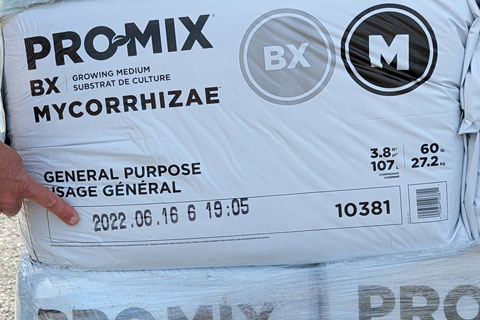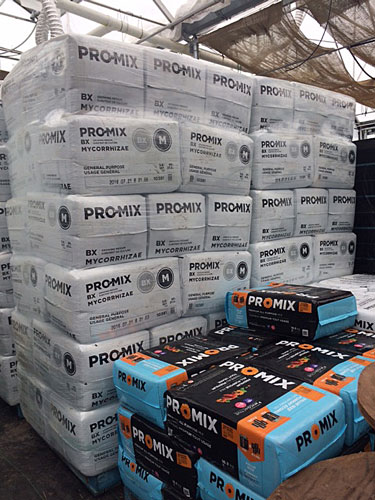9/1/2022
Addressing “Aged” Growing Media
Troy Buechel

With recent supply chain concerns, many growers may have ordered extra growing media to make sure they don’t run out during critical planting times. This is a great strategy, but what do you do with leftover growing media that may not be used until the following year?
Growing medium is a natural, biologically active product that changes as it ages. These changes occur in all peat and bark-based growing media and are most noticeable when the unused product is more than nine to 12 months old, depending on the storage conditions. The three major changes that can occur in packaged, unused growing medium include degradation of the wetting agent, decline of the starter fertilizer charge and/or possible increase in the pH of the growing medium.
 Figure 1. Most growing media have manufacturing dates stamped on the product. This product has its manufacturing dated listed as YYYY.MM.DD, so it was produced on June 16, 2022.
Figure 1. Most growing media have manufacturing dates stamped on the product. This product has its manufacturing dated listed as YYYY.MM.DD, so it was produced on June 16, 2022.
Wetting agent: Natural microorganisms in peat, bark and other organic components biodegrade the wetting agent so growers may have trouble wetting soilless growing medium nine months after manufacturing for a peat-based growing medium or six months for bark-based growing medium (Figure 1). A typical symptom is “ponding” of water on the growing media surface and slower water infiltration. This can also create pockets of dry and wet growing medium within cells and pots, which can lead to uneven drying and inconsistent crop growth.
If your unused growing medium is hard to wet, wetting agent solution can be pre-incorporated into the growing medium during the mixing or bale decompression process. Add about 2 to 3 gallons of wetting agent solution per 3.8 cu. ft. bale of growing media. However, if the containers are already filled and a wetting problem is found, then wetting agent solution can be applied as a one-time drench using a fertilizer injector. It may take several passes with the wetting agent solution to completely saturate the growing medium. Once saturated, the wetting agent has now been refreshed and the growing medium should absorb water normally throughout the duration of the crop cycle.
Application rates depend on the product and the intended use. Most wetting agent application rates are similar among the popular products on the market. (Table 1 lists the recommended rates.) It’s recommended to confirm the application rate with the wetting agent label or contact your growing medium manufacturer for assistance.
Starter fertilizer charge: Most growing media are formulated with a starter fertilizer charge that lasts typically one week after planting. After the growing medium is manufactured and packaged, the starter fertilizer charge is slowly consumed over time by naturally occurring microorganisms found in peat moss, bark and other organic components. With cold storage temperatures, these microorganisms are less active, but warm temperatures favor microorganism activity and the biodegradation of fertilizer can be accelerated. Of the fertilizer elements added, nitrate and iron are consumed most rapidly.
 Pictured: It’s best to store packaged growing media in cool areas out of direct sun.
Pictured: It’s best to store packaged growing media in cool areas out of direct sun.
If the starter fertilizer charge in the growing medium is low, initial plant growth is very slow. To correct this, simply apply a 100-ppm nitrogen fertilizer solution (for seed germination media, apply 50 ppm nitrogen) at the time of planting using a complete, water-soluble fertilizer. This will minimize slow initial growth of newly transplanted plants. Fertilizer should then be applied throughout the growing cycle as would normally be supplied.
Limestone: Depending on the growing media manufacturer, dolomitic limestone, calcitic limestone or a combination of both are used to adjust the pH of the growing medium. Moisture within the product breaks down the limestone, so it adjusts the pH to a typical range of 5.2 to 5.8 after watering in.
If the growing medium is nine months old or older, it’s possible that the pH may be close to 6.0. However, if water seeps into packaged soilless medium and it’s wet for extended periods of time, limestone breaks down faster, so the pH of the growing medium will often climb up to the mid sixes or higher, depending on the growing medium. It’s best to test the pH of the growing medium to verify its pH before use.
If you have unused growing media with a high pH, it can be used for crops that can tolerate high pH, including geraniums, New Guinea impatiens, lisianthus, marigolds and pentas. It can be used for crops that are less sensitive to pH, such as impatiens, if a fertilizer with high potential acidity (such as 18-9-18, 20-7-20, etc.) is used to reduce the pH of a growing medium.
Proper storage of growing media: Keep in mind the “aging” process of any soilless mix is accelerated with heat, so it’s best to store packaged growing media in cool areas out of direct sun. You can allow it to freeze during the winter months. Cover with heavy plastic to avoid direct damage from the sun, product getting wet from rain and to keep out weed seed.
To assure the best performance from your growing medium, pay attention to manufacturing date and practice “first in, first out” stock rotation. Use older product first, especially with crops that are less sensitive to pH. Plan your usage accordingly to prevent product carryover from season to season. GT

Troy Buechel is a Horticulture Specialist—Northeastern U.S. for Premier Tech Growers & Consumers. He can be reached at BUET@premiertech.com.